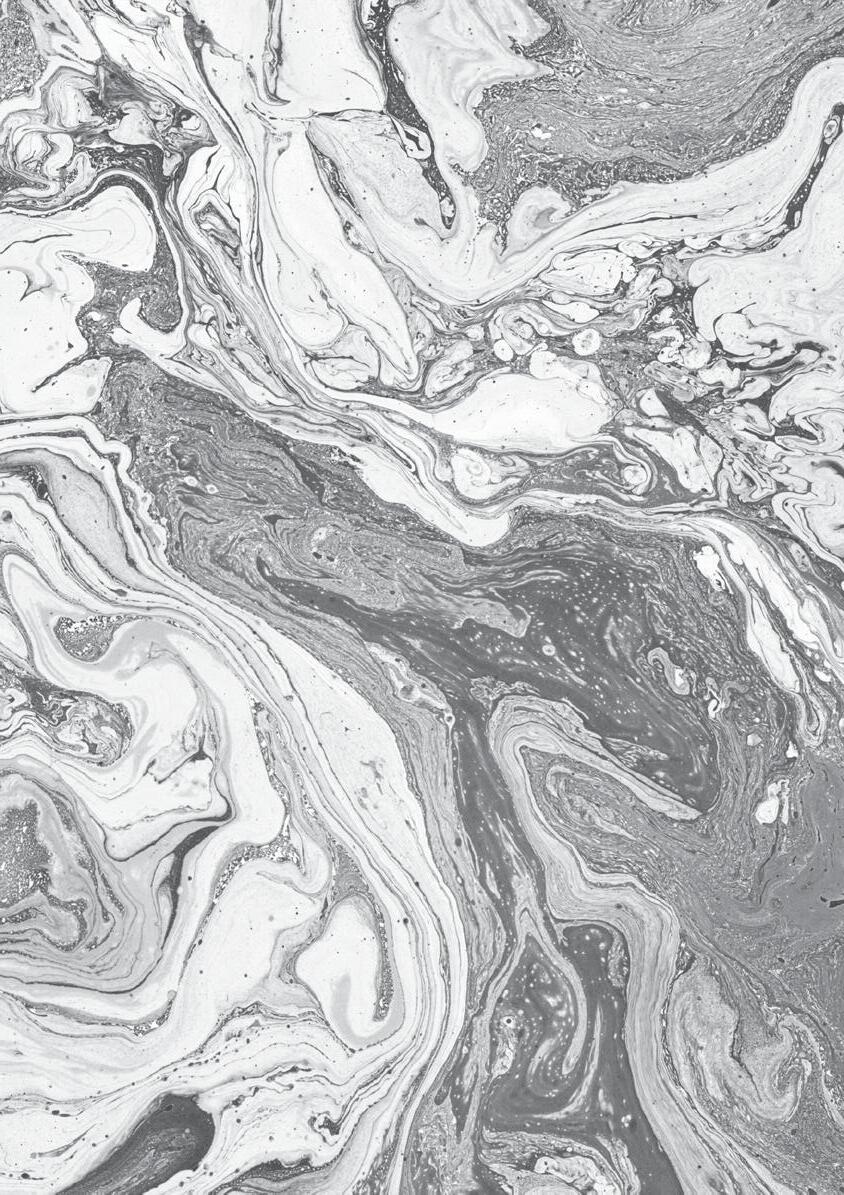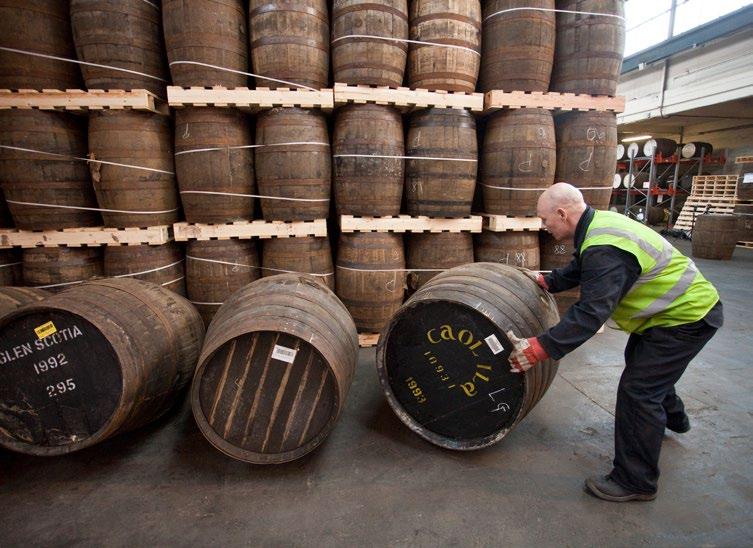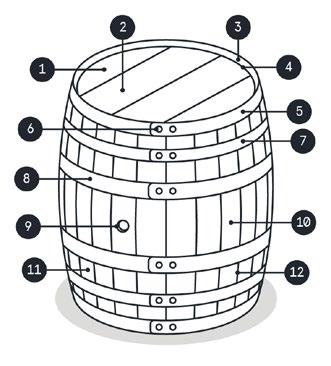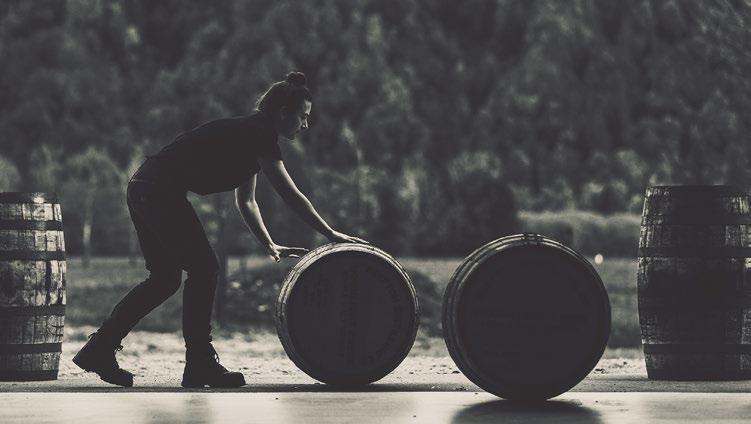
4 minute read
MIGHTY OAKEN CASKS
PART #1: WHISKY CAN ONLY BE MADE IN CASK
BY CHRIS MIDDLETON
Advertisement
The Scotch Malt Whisky Society and whisky are inextricably bound to the oaken cask. No oak container, no whisky — as defined by 20th-century legislation in the leading whisky-producing countries. Investigating oak cask’s decisive role in whisky flavour development weighs heavily on every Society release as it is the preeminent product point of difference in every release.
One oak cask caveat. Outturn is published in Australia, where the Commonwealth product identity laws for whisky only define ‘storage in wood’, not an oak cask, nor is there a minimum or maximum size vessel since the 1906 Spirits Act. The United States mandated ‘oak containers’ after Prohibition for American straight whisky, Scotch ‘oak casks’ must not exceed 700 litres since 1990, and sanctioned under the 2008 EU treaty. Irish whisky also specifies ‘wooden container’ and Canadian whisky in ‘small wood,’ meaning under 150 gallons (700 litres) from 1949. A whisky’s provenance must be scrutinised under the jurisdiction of each country’s laws. Regardless of the wood specification, oak is universally used to mature whisky due to its functional and sensory superiority.
There is a broad range of informed and conjectural opinions on how much flavour oak casks bring to whisky. While there is consensus that cask maturation is the most significant contributor to whisky flavour, quantifying the cask’s impact is more subjective than scientifically measurable. That’s because every cask and how it is stored is ever-so marginally different, causing nuanced flavour variances that make a definitive answer impossible. To answer this we’d need a massive Rubik tumbling over 1,200 flavonoid and aromatic compounds identified in whisky, against fifty million resting casks worldwide.

Opinions on the quantitative organoleptic contributions oak cask maturation deliver to whisky range from roughly 50% to around 80% of its flavour. All can be correct because endless variables determine the flavour profile of every disgorged whisky cask. Contributing factors are oak subspecies, vessel condition due to multiple reuses, cask capacities and entry proofs, environmental locations and exposures, the length of time stored in oak, and the new trend of finishing in another cask.
Since 1936, American straight whisky laws only allow maturation in new charred American oak barrels where the oak flavour leans towards the 80% quotient. Younger, two-year-old straight bourbon with less extraction and interaction (oxidation of esters) likely slips into the 70s%, and bourbon over 15 years old can skew towards over-extraction and might exceed the 80% threshold. Bourbon distilleries use the standard 200-litre barrel filled at lower proofs (55% to 62% abv), warehoused in much warmer, multi-storey oven-like tin-clad rick houses. In the colder British Isles, most whisky is stacked only a few casks deep in dunnage warehouses. British distilleries historically store whisky in larger casks — hogsheads (230L – 250L), larger puncheons (320L), butts and pipes (500L) at higher proof strength to bourbon (63.5% to +70% abv for grain), where the casks experience slower maturation with less water solubility. Malt-based whisky made in Scotland, Ireland, Japan and Australia avoids new oak as extraction is too assertive. Instead, the second-use or multi-filled casks are de rigour. Ex-sherry casks dominated whisky maturation in the British Isles until the 1970s, superseded by cheaper ex-bourbon barrels as global sherry sales contracted. In using seconduse casks, many undesirable compounds are leeched out, notably bitter tannin, while impregnating the staves with traces of the previous occupant’s flavourings — making the taste of whisky resemble Christmas cake (sherry cask influence) or crème brûlée (exbourbon barrel).

The age of modern whisky is intimately bound to cask maturation. Modern whisky is only two hundred and fifty years old. Before the late 18th century, whisky was exclusively the native spirit of Ireland, Scotland and inchoate North America, and most compounded as cordials or sold as raw distillate for adding to punches. Rum dominated domestic spirit consumption in Scotland and North America until the 1780s and England until the 1860s. Sea-voyaged rum from the tropical West Indies and imported French brandy taught drinkers the sensory benefits of cask maturation and a willingness to pay a premium for a smoother and more flavoursome aged spirit.
The relationship between cask and whisky shares origins with Celtic culture. The Celts were the inventors of the cask, and their beer culture is direct lineage to their diaspora through Western Europe to the British Isles, where they distilled beer. The Celtic language peregrinated to Ireland and later Scotland giving the vernacular Gaelic terms uisce-beatha (Irish Gaelige) and usquebaugh (Scottish Gaidhlig), from the Latin aqua vitae, the water of life. Anglicised and abbreviated to whisky in the early 18th century, this Anglo term was universally adopted. Many Celtic designations identifying cask types trace their etymology to the Celtic language.
Future issues of Outturn will decode cask meanings and the importance of different oak species in contributing to the dominant flavours in whisky.

Chris Middleton is the director of Whisky Academy, founding management member of Starward Distillery, and longterm SMWS member. We look forward to reading his next instalments to this series over the coming Outturns.
The 12 Flavour Profiles Of The Smws
BITTER LEMON
BEESWAX
SPARKLING WINE
SOUR APPLE SWEETS
MENTHOLS
PLUM TARTS
RHUBARB TOASTED COCONUT
CHILLI CHOCOLATE
PIPE TOBACCO
PENCIL SHAVINGS
SANDALWOOD
NUTMEG
CHARRED STAVE
WATERMELON
PIMMS
TURKISH DELIGHT
APPLE PIE
CANDIED ORANGE SLICES
APRICOT
CUSTARD SWEETS
GINGERBREAD
HOT CROSS BUNS
BALSAMIC STRAWBERRIES
FRESH OAK
MULLED WINE
CARDAMOM
THAI SWEET CHILLI CRISPS
TREACLE TOFFEE
SALTED CARAMEL
MINCEMEAT PIE
ORANGE PEEL
PRUNES
DEMERARA
SHERRY TRIFLE
CIGAR BOX
SCENTED CANDLES
POLISHED WOOD
MAPLE SYRUP
OLD BOOKS
APPLE STRUDEL
PERFUMED PEAR
BANANA CHIPS
HONEYDEW MELON
COCONUT ICE CREAM
GREEN TEA
BREAKFAST CEREAL
WHITE PEPPER
FRESH LAUNDRY
TOASTED OAK
CORIANDER SEED
BANANA SPLIT
ROOT GINGER
PASSIONFRUIT
CARPENTER'S WORKSHOP
PINEAPPLE SORBET
TARRY ROPE
OYSTERS
BEACH BONFIRE
BARBECUED PRAWNS
SALTED CARAMEL
BOATYARD
PEBBLE BEACH
SMOKED SALMON
LAPSANG SOUCHONG TEA
ROCK POOLS
SEA BREEZE
BURNT TWIGS
DENTIST'S WAITING ROOM
GARDEN BONFIRE
ROAST ROSEMARY LAMB
KIPPERS
FIRST AID BOX
HERBAL SMOKE
SHIP'S ENGINE ROOM
SMOKY BACON CRISPS
PHENOLIC
CHIMNEY SOOT
SMOKED MACKEREL
GUNPOWDER
CIGAR BUTTS
FARMYARD
WOOD BURNING STOVE
STEAM TRAIN


